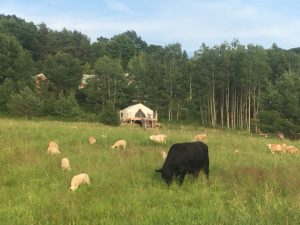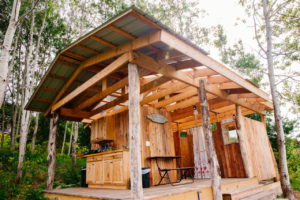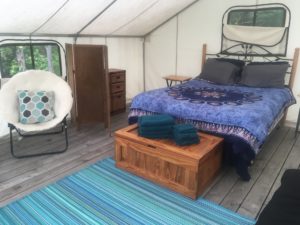Consider Glamping to Diversify Income from Your Scenic Pastures
The Cornell Small Farms Program’s Erica Frenay details how a glamping operation has helped diversify her farm’s income stream.
In the early 2000’s, I had the joy of spending a memorable 4 days with Bill Burrows, a 6th-generation rancher and Holistic Management practitioner from Northern California. Bill told us the story of how his family very nearly lost the ranch in the 1980’s when the bottom fell out of the cattle market, and how a change in his thinking helped them recover, by developing multiple new enterprises, including hosting small groups of guests for weekend-long hunting expeditions. His words stayed with me: “I switched from seeing myself as a cattle producer to a sunlight harvester. Aside from cattle, how else could I capture sunlight to diversify our farm income and support my family on this land?” This idea of thinking creatively about ways to support a livelihood on the land stayed with me.
Fast Forward a Decade

While you may be used to that pastoral view of animals peacefully foraging, for farm guests it could be their first exposure to the power of grazing!
Erica Frenay / Shelterbelt Farms
In 2010, just after my husband and I started our farm on a very wet, thin-soiled, overgrown property. We were standing in a field that, despite being unmanaged for 30+ years, had only produced 12″ of forage. Most of that was knapweed. “Well, at least it’s got a pretty view, and the sunsets will be gorgeous from here,” my husband said, aiming for a hopeful tone. The view seemed to be the only thing going for that field.
But Bill’s words came back to me, and an idea began to take shape. What if the best way to harvest the sunlight from that field was to host overnight guests? The location was easily accessible from our driveway, yet far enough removed from our home to feel private. My husband Craig and I love to meet new people and talk about farming, and a driving force behind much of what we do on our farm is helping non-farmers reconnect with food and soil. We began to investigate what this might look like.
Eight more years went by in a blur of building – our home, a barn, 3 high tunnels, fencing, an on-farm apartment – having kids, and starting and running two businesses. So we tabled this idea of overnight accommodations, and then in 2018 we circled back to it.
The Glamping Option

This structure has electricity and light, seasonal plumbing for 2 flush toilets, 2 hot showers, and a simple rustic camp kitchen stocked with dishes, 2-burner propane stove, and basic cooking amenities.
Erica Frenay / Shelterbelt Farms
We especially liked the idea of “glamping,” a portmanteau of “glamorous” and “camping.” Camping in comfort, in a spacious tent furnished with a bed, table and chairs, and with hot showers and flush toilets nearby, seemed appealing to a wide range of people. We live in the Finger Lakes Region of NY, an attractive region with a robust tourism scene. It felt like an obvious choice, especially since a glamping enterprise wouldn’t interfere with our existing use of the field, which was to graze it 2-3 times/year. In fact, that seemed like a bonus: a few times a year, guests could look down from the front porch of their tent and enjoy a pastoral view of sheep and cattle grazing contentedly.
So we researched other glamping enterprises, tent manufacturers, and our local regulations. We knew we wanted to provide hot showers to guests, and also wanted to offer a space for them to cook meals, to take advantage of the eggs, meat, honey, and produce for sale in our self-serve farm store. So we conceived of a “bath house” with sinks, toilets, showers, and a kitchen. In this way, we could avoid running electric and water to each tent, and keep these services centrally-located in one building, as many campgrounds do. In researching, we learned that while our County Dept of Health didn’t care if we dug pit toilets for our guests, they considered the water from the sinks and showers as “blackwater,” requiring a septic system for treatment. Ooph. That was our largest single investment in this enterprise.
Planning and Budgeting With Regulations in Mind

The tent comfortably sleeps 4 guests on 2 beds. If you decide to provide all bedding and towels, as we do, don’t forget to take into account all the extra laundry you’ll be doing!
Erica Frenay / Shelterbelt Farms
We mapped out an enterprise budget and played with numbers. If this went well, how many tents might we want to host? This was partly a philosophical question: how many people did we really want to have on our site? But it was also logistical: how often do we really want to be doing laundry, and how much time do we have for greeting and managing guests? (Answer: not enough!) And of course it was financial: more tents could bring in more income to cover the costs of building and maintaining the bath house. But what was the minimum needed to cover this overhead?
Finally, there was a regulatory component too. We do not have zoning restrictions in our area, but we did have to address the aforementioned Dept of Health requirement that we install a septic system. We also learned through our research that if we exceeded 4 tents, we would be subject to more restrictive campground regulations. Four seemed like the most tents we’d ever want to have anyway, so that was an easy upper limit to set.
And then…
And then came a novel coronavirus to remind humans that nothing in life is certain, save change. What does COVID mean for our glamping enterprise? To start with, we delayed opening this year by one month, since entertainment and tourism-related businesses were still closed here in upstate NY through most of June, and visitors to the area were scant. But our prediction has proven accurate that there would be pent-up demand from people with “quarantine fatigue” and that anyone willing to travel would prefer to stay in accommodations where maintaining spatial distance is easy. We offer a very private setting with plenty of space, and we currently have one tent set up, so we host only one party of guests at a time. Our initial fear, that COVID might mean the end of our agritourism enterprise, has pivoted 180 degrees into elation at the interest in our glamping set-up. We have been booked every single night since opening on June 26!
Glamping may not be for everyone, but if you’ve got a nice setting, you like people, and you’d like to find a way to generate more income from your farm or ranch, it may just be for you. I spend so much time working in my pastures that I often forget to appreciate how beautiful they are. Most of the guests who’ve stayed with us come from urban areas, and their exclamations remind me of all that I take for granted.
Now we harvest sunlight to turn it into meat, fruit, vegetables, eggs… and satisfied guests. Thanks to the late Bill Burroughs for planting that seed so many years ago.
Shelterbelt Farm’s glamping tent is listed on Airbnb, Hipcamp, and GlampingHub, as well as the VisitIthaca.com website. Check out all the details here.
A version of this article originally appeared in On Pasture.

